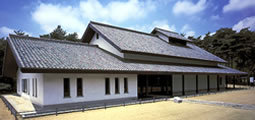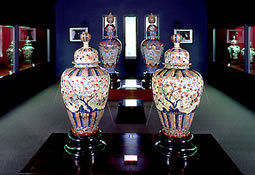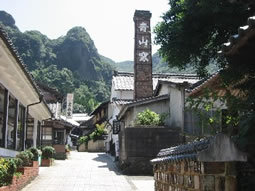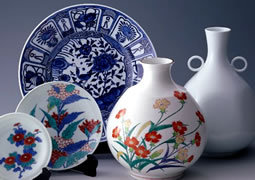
http://www.activetours.co.jp/en/
Mobile Website
Mobile Website
Active Tours
2-3-7 Yahatacho, Musashino, Tokyo 180-0011
TEL:0422-38-8026
FAX:0422-38-8036
TEL:0422-38-8026
FAX:0422-38-8036
005713
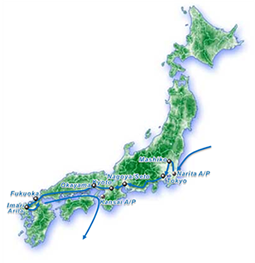
Japanese ceramics,’ Yaki’, have a long tradition of craftsmanship, from the beautiful, delicate Arita earthenware (Porcelain) to the rough yet refined Raku stoneware (Pottery).
Ceramics were especially in demand once the cult of the tea ceremony had spread, in the 15th and 16th centuries. Ri Sampei, of Korean origin, who is known as the father of Japanese porcelain, was the founder of the Izumiyama kaolin quarry, which continues to produce raw material for porcelain manufacture to this day. During the Edo period (1603-1868), when Japan isolated itself from the world, porcelain exports to the West were a significant factor in the economy of that period. The Japanese porcelain was extensively imported into Europe by the Dutch East India Company and was of great influence on European Porcelain in 19th century.
10-day Tour, visiting Japan’s popular ceramic producing towns & museums: Mashiko, Seto, Kyoto, Bizen, Arita/Imari, Karatsu.
Japanese ceramics are in traditional expression yet innovative in technology.
Ceramics were especially in demand once the cult of the tea ceremony had spread, in the 15th and 16th centuries. Ri Sampei, of Korean origin, who is known as the father of Japanese porcelain, was the founder of the Izumiyama kaolin quarry, which continues to produce raw material for porcelain manufacture to this day. During the Edo period (1603-1868), when Japan isolated itself from the world, porcelain exports to the West were a significant factor in the economy of that period. The Japanese porcelain was extensively imported into Europe by the Dutch East India Company and was of great influence on European Porcelain in 19th century.
10-day Tour, visiting Japan’s popular ceramic producing towns & museums: Mashiko, Seto, Kyoto, Bizen, Arita/Imari, Karatsu.
Japanese ceramics are in traditional expression yet innovative in technology.
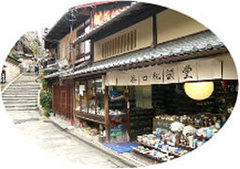
|
In Kyoto, there are a lot of ceramic shops, including antique shops, gathered around Kiyomizu Temple, and you can enjoy window-shopping.
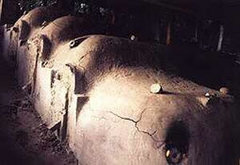
|
Nobori-gama = Climbing Kiln
Main type of kiln used in Japan since the 17th century. It is preferred for glazed ware as it gives consistency and predictability to kiln output. The potter controls about 85% of the process but other factors are beyond control, like weather, wood-condition, and kiln atmosphere, which are left to God.
Main type of kiln used in Japan since the 17th century. It is preferred for glazed ware as it gives consistency and predictability to kiln output. The potter controls about 85% of the process but other factors are beyond control, like weather, wood-condition, and kiln atmosphere, which are left to God.
|
Day 1
Narita Int’l Airport arrival | Mashiko |
Meet and greet by a guide and proceed to Mashiko, one of the leading pottery manufacturing places, developed in 19th Century. On the way to Mashiko, visit Kurita Museum, Ashikaga city, one of the largest Museums in the world with exclusive collections of Porcelain from the Imari and Nabeshima styles. Upon arrival in Mashiko, visit to the private kilns/potteries and the Museum. (Mashiko) |
|
Day 2
Tokyo |
Full-day tour, visiting contemporary architects’ works by Kenzo Tange, Kazuyo Sejima, Kengo Kuma, Kisho Kurokawa, and others.(Tokyo)
|
|
Day 3
Tokyo |
Full-day tour, visiting construction site of Tokyo Sky Tree, The National Museum of Western Art designed by Le Corbusier, and Odaiba area. (Tokyo) |
|
Day 4
Tokyo | Kyoto |
Board the Tokaido Shinkansen Train to Kyoto. Upon arrival in Kyoto, visit of Kyoto station to observe the architecture by Hiroshi Hara. Then, visit Ryoan-ji (stone garden) and Kinkaku-ji Golden Pavillion). (Kyoto) |
|
Day 5
Kyoto |
Tour of Kyoto, visiting Ginkaku-ji (Togu-do = Shoin ?Zukuri), Machi-ya (a typical wooden house for local inhabitants), and Kiyomizu Temple, etc. (Kyoto)
|
|
Day 6
Kyoto | Uji | Nara |
Departure for Uji to visit Byodo-in, built in 1053. Phoenix hall’s with wings outstretched like a phoenix in flight. Then to Nara, visiting Horyu-ji, the oldest wooden architecture in the world, with a JIA member. (Nara)
|
|
Day 7
Nara | Kobe |
Morning, visit Todai-ji. Daibutsu-den (Buddha hall) is the largest wooden structure in the world, built in the 17th century. Then, transfer to Kobe, to visit Takenaka Carpentry Museum (where there is an exhibition of tools for Japan’s unique way of working with wood to convey to future generations the spirit and attitudes of the traditional Japanese carpenters). Hyogo Prefectural Museum of Art, by Tadao Ando. (Kobe) |
|
Day 8
Kobe | Himeji | Kurashiki |
Transfer to Himeji either by coach or train. Upon arrival, visit Himeji Centre for Research into Castles and Fortifications to attend a Seminar on Himeji Castle, followed by a visit to the castle’s re-construction site.
Then to Kurashiki either by coach or train. (Kurashiki) |
|
Day 9
Kurashiki | Naoshima |
Morning stroll in the historical quarter or Kurashiki, full of storehouses with lattice windows, white-wall houses and with black roof tiles. Then, to Naoshima by ferry.In Naoshima, to visit Chichu Art Museum by Tadao Ando, the Art House Project, and Overnight stay in Benesse House by Tadao Ando. (Naoshima)
|
|
Day 10
Naoshima | Osaka |
Transfer to Okayama to take Sanyo Shinkansen to Osaka. Upon arrival, visit the Umeda Sky Bldg. by Hiroshi Hara, Etoile Shinsaibashi Bldg. by Kengo Kuma, Kilin Plaza by Hiroshi Naito, The National Museum of Art by Cesar Pelli.
Stroll over Doton-bori area will give the visitors another inspiration. (Osaka) |
|
Day 11
Osaka | Kansai Int’l Airport (KIX) Departure |
After breakfast, transfer to Kansai Int’l Airport (KIX).
Tour ends at airport. |





